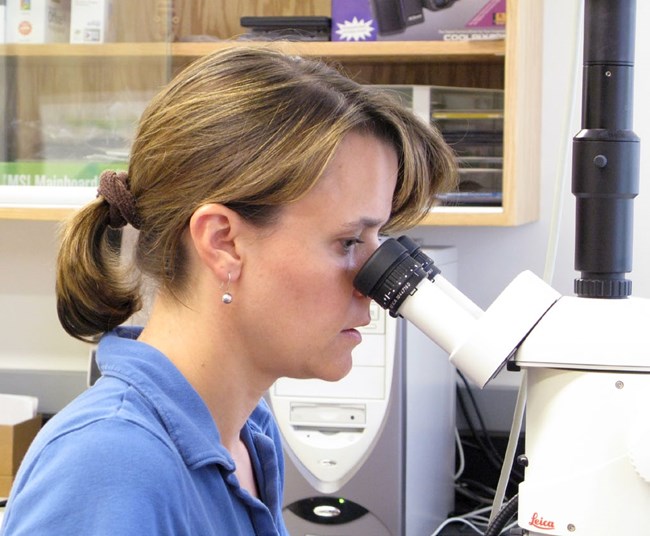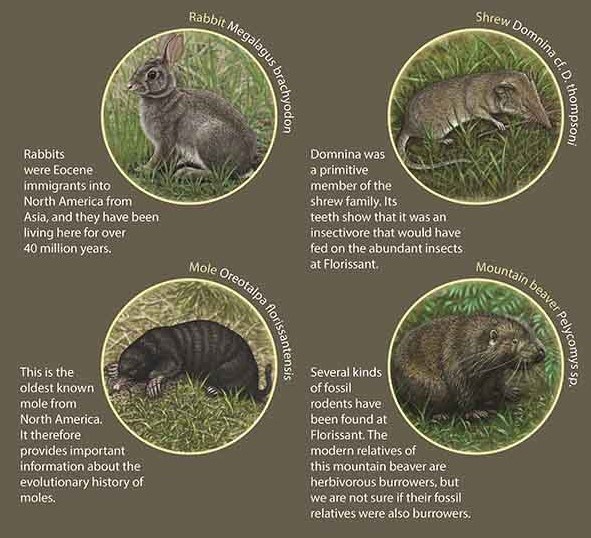

In Search of Fossil MammalsWhat kinds of mammals lived here during the Eocene?Unlike plants and insects, Florissant's mammal fossils are rarely found in the lake shale. The search for mammals led paleontologists to new study sites with different rock types deposited near streams. Before this study began, only five types of Florissant fossil mammals were known. These mammals were much larger than the ones Dr. Eberle and her students, Karen Lloyd and Marie Worley-Georg, discovered... Rabbits were Eocene immigrants to North America from Asia, and they have been living here for over 40 million years. Domnina was a primitive member of the shrew family. Its teeth show that it was an insectivore that would have fed on the abundant insects at Florissant Mole (Oreotalpa florissantensis) this is the oldest known mole from North America. It therefore provides important information about the evolutionary history of moles. Mountain Beaver (Pelycomys sp.) Several kinds of rodents have been found at Florissant. The modern relatives of the mountain beaver are herbivorous burrowers, but we are not sure if their fossil relatives were also burrowers. A Closer LookDr. Eberle and her students, Karen Lloyd and Marie Worley-Georg, tripled the number of fossil mammals discovered from Florissant, most of which were extremely small. Their method required excavation at new sites and in new layers of rock.Ultimately, they found that Eocene Florissant contained a much more diverse collection of mammals than originally thought. Are you sure the fossils are really that old?While fossils are very useful tools for telling geologic time, they are best used alongside other dating techniques. We can be more certain of the age if multiple dating methods produce the same result. Florissant's age of 34 million years is not only supported by brontothere fossils, but also by dating minerals found in volcanic rocks.Animal Oddities: Telling TimeConsider the plants and insects you've come across so far. Fossilized leaves, insects, and trees might look surprisingly familiar. Florissant's mammals, on the other hand, probably aren't so easy to recognize in comparison to modern mammals.Mammals have changed relatively rapidly through time. For this reason, the mammals seem much more unusual than some of the other fossils found here. Rapid evolution makes fossil mammals well-suited to dating rock layers and geologic events. Mesohippus (small horse): 40-28 Million Years ago Mesohippus was a small three-toed horse that was only about two feet tall at the shoulders. its teeth show that it had a mixed diet of leaves, tender twigs, and grass- similar to today's elk. Megacerops (Brontothere): 37-33.9 million years ago Brontotheres are the largest fossil mammals known from Florissant- about the height of an elephant at the shoulders. They may resemble rhinoceroses but they actually belong to a family that became extinct at the end of the Eocene. 
Northern RelationsSimilarities between mammals from Florissant and northern states tell paleontologists that the climate was relatively cool here during the end of the Eocene. This may be because it was an upland area.It turns out that Eocene mammals found north of Colorado have more in common with Florissant's ancient mammals than those from more southern sites. This conclusion provides yet another line of evidence that climate helped shape what could survive here 34 million years ago. |
Last updated: September 17, 2022
